Julian Opie on VR, shuffle dancing and obsessive art collecting
We interview artist Julian Opie on life, work and his new playground of VR at Lisson gallery (until 15 April), and peek behind the scenes of his London studio
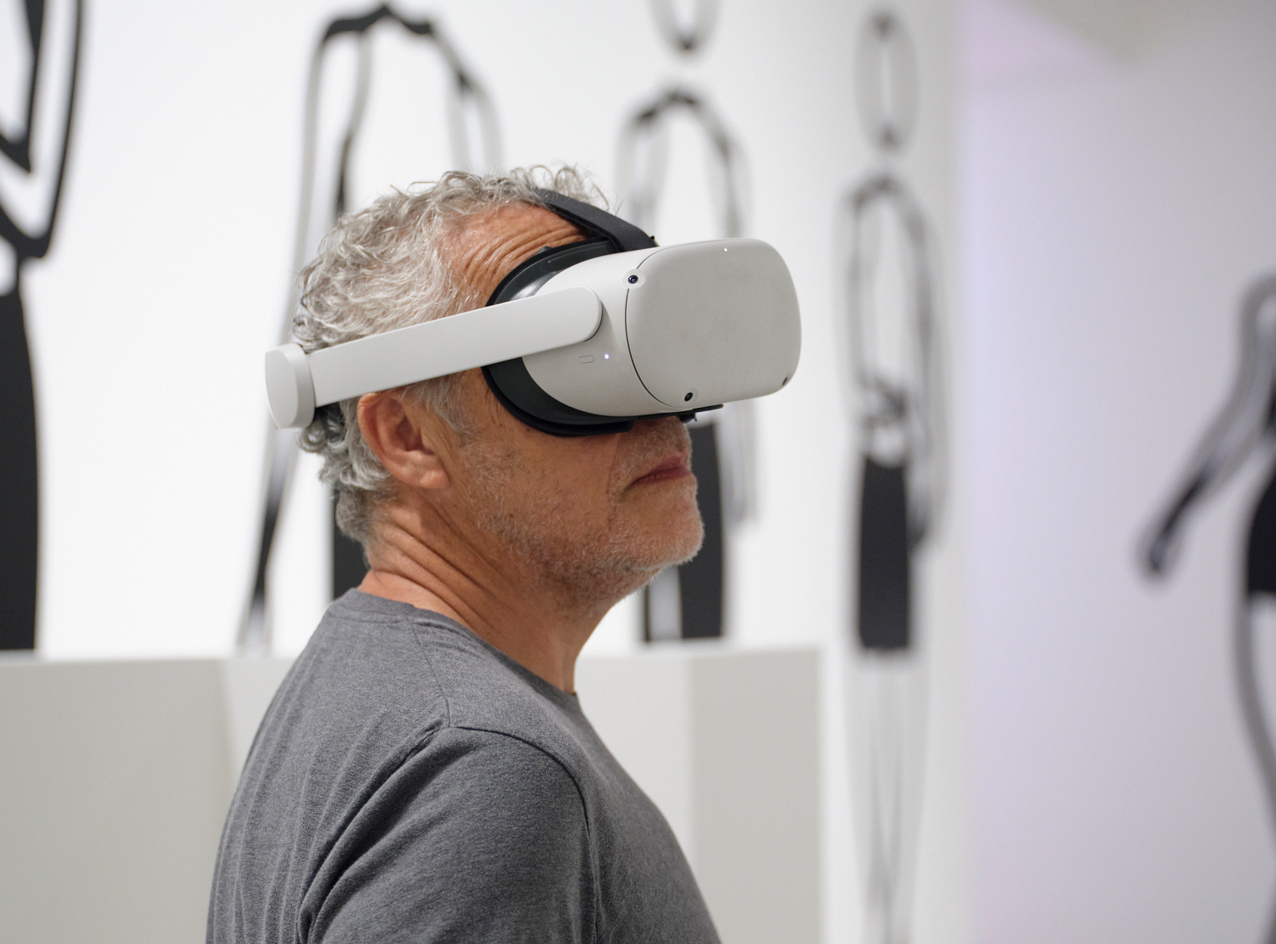
Julian Opie's art is a language of its own. Its vocabulary is the essence of everyday human experiences; its grammar is sensation.
The acclaimed British artist’s name is synonymous with Pop Art-contoured, heavily-lined figures in motion, landscapes and architecture. Boiled down to states of pure reduction, they appeal to our most fundamental capacity for perception and recognition.
Ever the embracer of technological innovation, Opie has recently been immersed in the world of virtual reality. In 'Julian Opie: OP.VR@LISSON/London', until 15 April 2023, the artist has conceived a playground of colour and movement via an ambitious new VR work and a dynamic series of animated sequences based on a high-energy, TikTok-viral dance sequence.
Julian Opie, Dance 1, (2022), Animated poster, © Julian Opie; Courtesy Lisson Gallery
Wallpaper*: Where are you right now?
Julian Opie: I’m sitting on the stairs at Lisson Gallery, London, installing a new exhibition. Many of the artworks are Wi-Fi-connected so my team and I can work on them remotely. I’m also installing a show in Changsha, China, this week, which has been done remotely. To work like this and plan complicated installations, I developed a VR system to allow me to visualise works in new spaces.
W*: Describe your studio
Wallpaper* Newsletter
Receive our daily digest of inspiration, escapism and design stories from around the world direct to your inbox.
JO: It’s a building in Shoreditch that I bought back in the 1980s when it seemed a very remote and run-down area. Now it’s super lively and I’m usually the oldest person around.
I set up a 9m by 5m empty cardboard space in my studio to allow me to look at works in VR and move freely around them with goggles. I found myself enjoying just being in this alternative world and set about making an exhibition that would share this experience. The cardboard room takes up the top floor of my studio – where I work alone with a computer, a double-screen display and a digital drawing pad. The floor below has an office and a room for the technical digital team. I hang other artists’ work on these two floors and battle the tide of samples and tests that covers most surfaces. The ground floor is usually full of crates and works coming in from various factories and workshops. I hang my own works here to test, judge and photograph. The basement has a workshop with a large digital printing machine.
The whole building feels like home and when I arrive on my bike each morning an hour or so before anyone else I feel a sense of calm. I have been there for so long that the space and my work seem locked together.
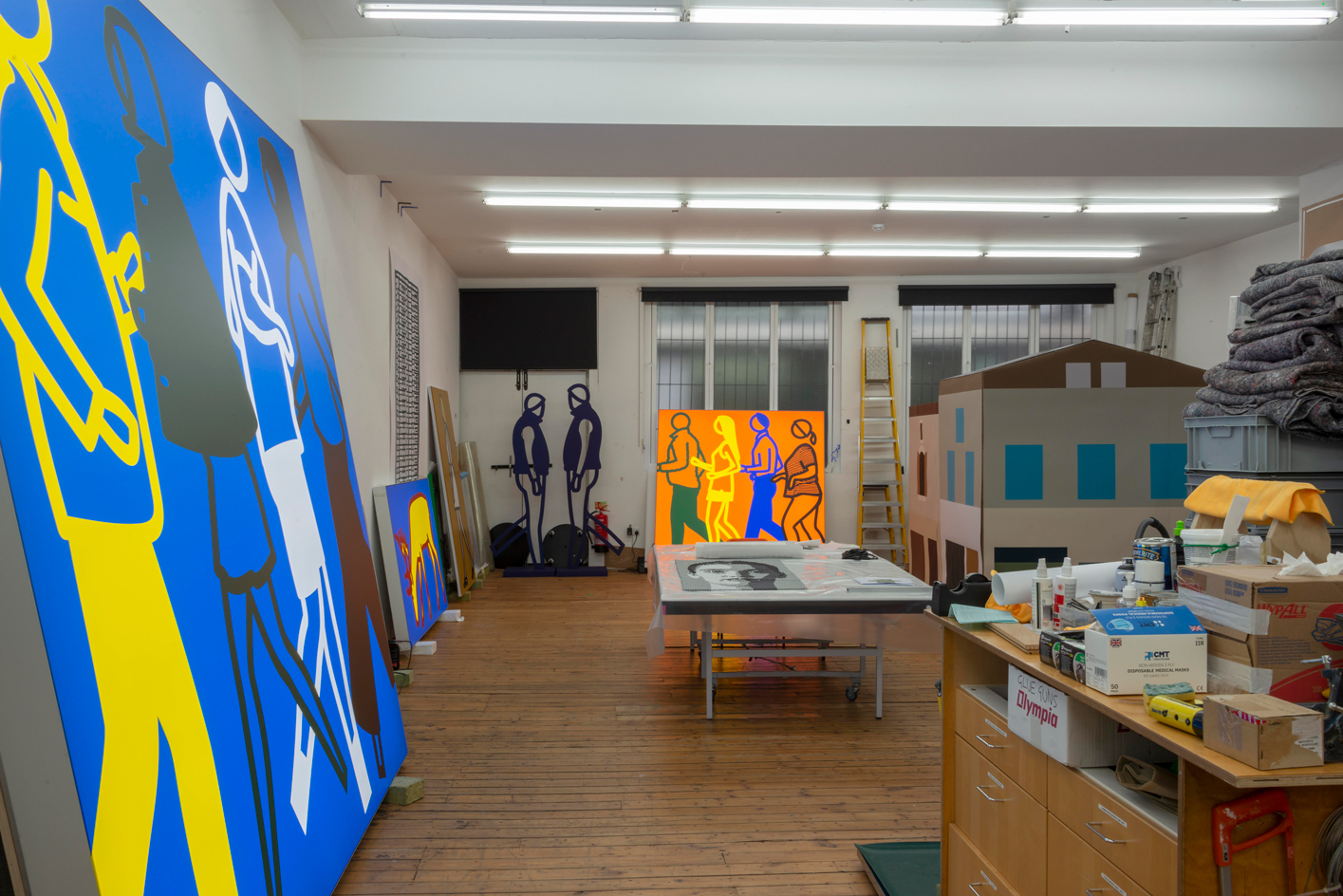
Julian Opie's studio in Shoreditch, London
W*: What was the first piece of art you remember seeing, and how did it make you feel?
JO: My mother, who always painted for pleasure, had wanted to go to art school but her father felt it inappropriate for a girl, so she studied singing. But her brother went to art school and opened Cranks health food restaurant on Carnaby Street in the 1960s. Cranks was very involved in ceramics and classical music and I grew up surrounded by [20th-century] English art prints on the wall by Julian Trevelyan, Paul Nash, Kit Wood and Graham Sutherland. My father always said he couldn’t draw a straight line but he was keen on furniture and had Charles Eames and Robin Day chairs in his college rooms where he taught economics.
W*: Where and when are you most productive?
JO: I’m productive in my studio but the ideas begin outside. I’m particularly aware of the world when I’m passing through it. On foot or bike, plane or car, train or boat. Perhaps the mundanity of travel opens my eyes and the movement through and around objects and places brings them to life for me. I gather images, materials and methods of fabrication in museums and temples, airports and motorways. The way the world is put together and the languages that are used become my palettes.
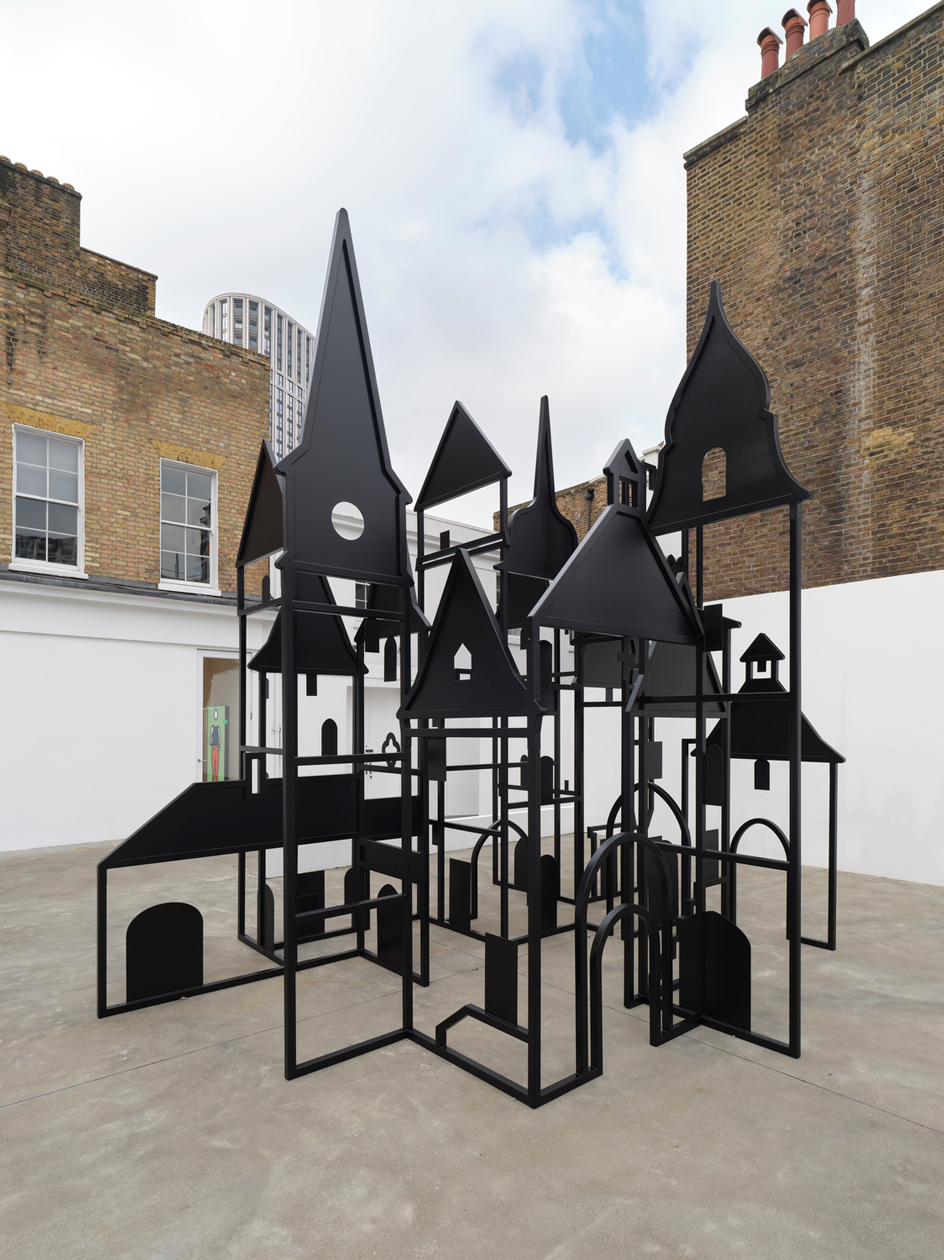
Installation view: Julian Opie, 'OP.VR@LISSON/London'
W*: What’s the most important object you own?
JO: I like my Orbea electric bike and my now-vintage Peugeot 505 estate, and I always carry my father’s penknife in my pocket. I’m not that attached to objects, but I’m obsessed with owning art by other people. I have been buying and swapping art for years now and have many more things than I have walls to hang them on. Owning art gives me ideas and a justification for my own work. It makes me feel connected to the world and history and people. If I feel challenged by other art, at least I can buy it. If you can’t beat them, collect them.
W*: What’s the last thing you read, watched, or listened to?
JO: A Short History of China (which is not short at all). I’m working a lot in China and wanted to know more about the place. My education seemed to assume that history only happened in the West so I’m pretty ignorant. I have been looking a lot at tribal art from Borneo, Sulawesi and Vietnam, the Austronesian cultures which originated in China. My wife Aniela and I just finished the Happy Valley police thriller: a gritty story and great acting. We also watched all of Doc Martin, which my daughter appears in.
Music-wise, I’m mostly listening to dance music, such as Armin van Buuren and Paul van Dyk. I like the upbeat energy and emotional longing in techno music. I also just received Max Richter’s album, Sleep – I love his music and we once worked together for a ballet by Wayne McGregor. I swapped an album cover image for a looped piece of his music that I used in an artwork. Hania Rani and Nils Frahm are also great in a similar ambient contemporary classical vein.
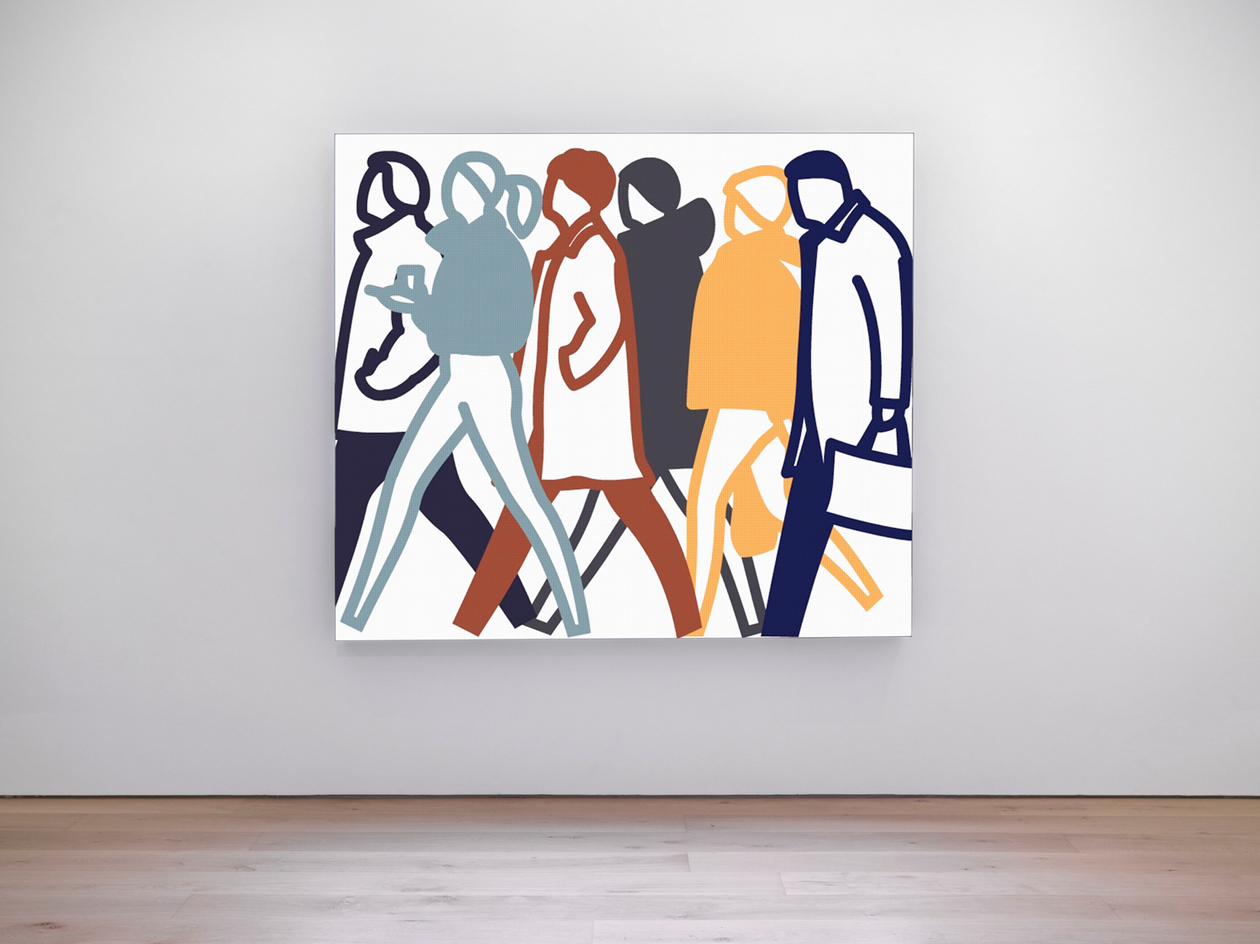
Installation view: Julian Opie, 'OP.VR@LISSON/London'
W*: How do you switch off? Do you switch off?
JO: Headphones and sci-fi books at home. Moped rides in the French countryside and walks along the coastal path in Cornwall and on Hampstead Heath.
W*: Do you collect anything?
JO: I avidly collect art. It started with Japanese prints, then moved back in time to English and French Old Master portraits and then Roman and Greek art and Egyptian art. Then sideways to Austronesian art, wooden statues and bead work and, more recently, contemporary art. When I see something that makes sense to me, I can’t resist. It’s mostly images of people. I’m not sure why. I justify the expense by believing that it helps me make my work.
W*: What’s your most memorable career moment to date?
JO: I go from waves of great excitement and belief in what I’m doing to a sense of rejection and a desire to move on and away. This applies to the artworks I produce and the exhibitions I make. I tend to think the next work and the next exhibition will be the best and will blow people away. Generally, I then feel it wasn’t so great but the next one will be. I was lucky enough to have a one-person show at the Hayward Gallery in my mid-thirties just when I had my first child, Elena. The show seemed to define what I had done and where I was going. I have been rethinking and replaying those themes ever since. Maybe that was the moment I felt I had a solid base from which to work.
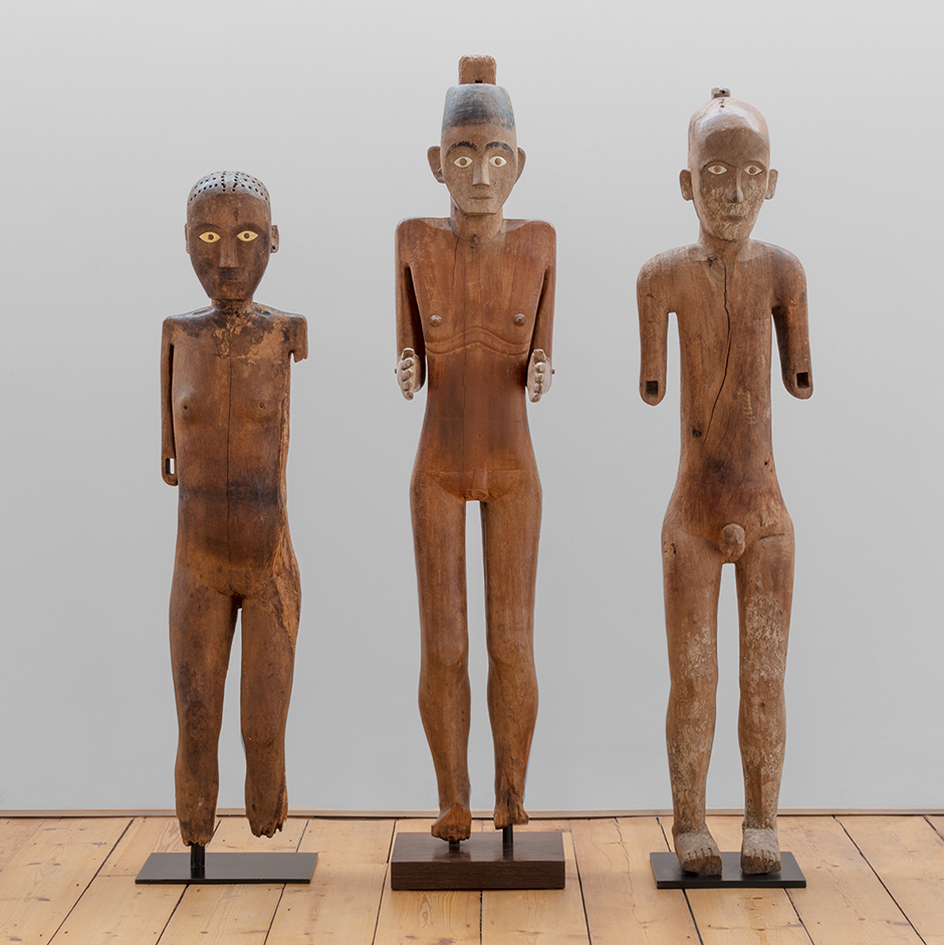
Tau Tau figures. Toraja people, Sulawesi. Mid-19th to mid-20th century, inside Julian Opie's London studio
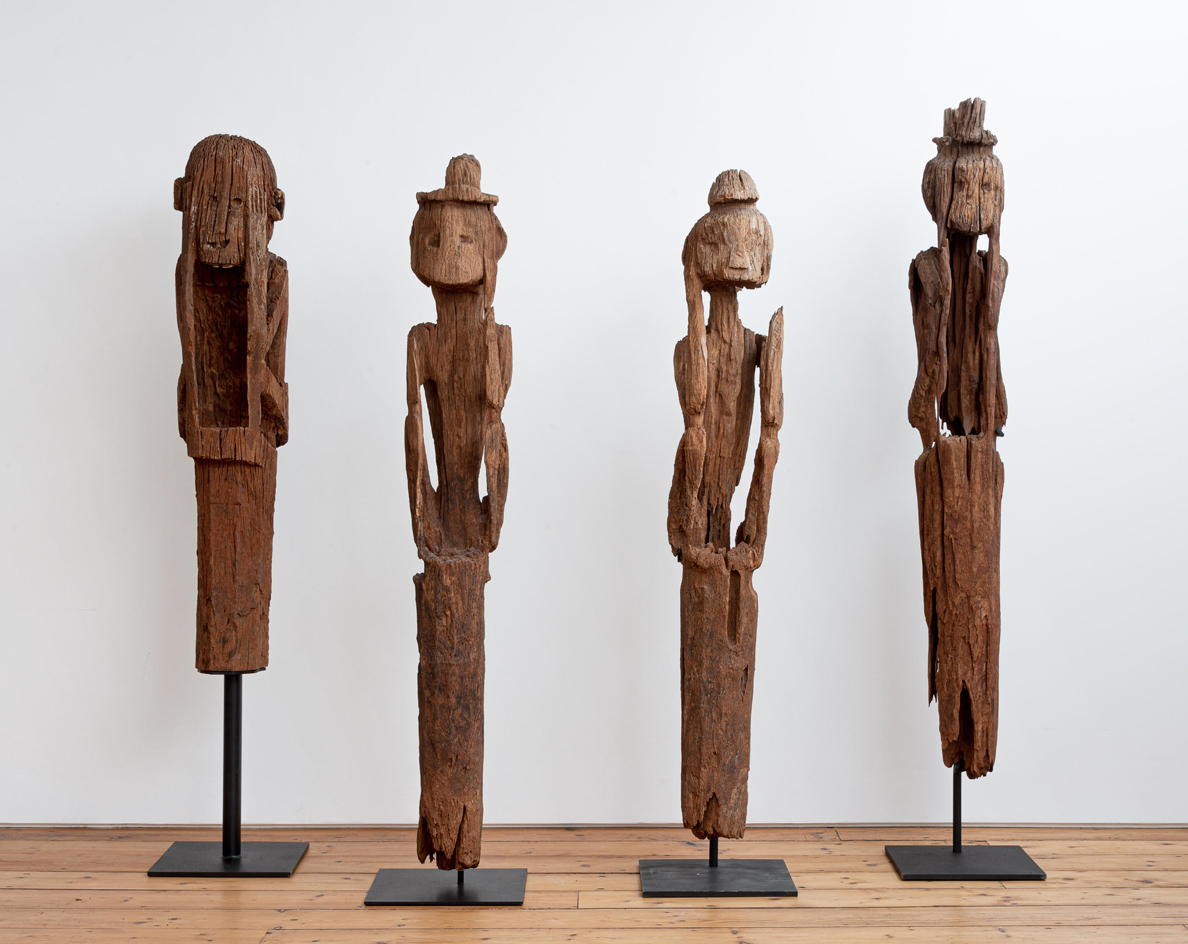
Hand-carved wooden mourning figures. Jorai people. Late 19th to early 20th century
W*: If you weren’t an artist, what would you have been?
JO: An anthropologist maybe. From an early age, I have read a lot about early humans and I had a place to study anthropology at university – or a primary school teacher like my mother perhaps. I’m better with little kids than adults really but I’m not sure I have the energy for teaching. My favourite job I ever had (apart from making art) was driving a tractor collecting rubbish on a kibbutz in the Golan Heights.
W*: You’ve just debuted a new VR work at Lisson gallery. Why VR, and where will you transport viewers?
JO: The whole show is about looking, navigation and ways of reading the world. Some of the show is in VR, some [works] are in the gallery spaces and some are outside. Additionally, we have also presented work at Bond Street Tube station and created a sound and image invitation card. TVR gaming goggles use technology to allow one to wander around a space and see drawn objects and images as if they were in the space with you. It’s a crude and simplified version of what we all do all day – exist as reflections of our plotted world sensing ourselves against what we perceive via sound and touch and vision. Although the goggles are a bit like snorkelling, your brain soon gives up and accepts this new reality. It allows me to make an exhibition that physics and practical limitations would not normally allow, and literally enter an imagined world. From Masaccio to Miyazaki (Studio Ghibli), this has been the dream of many artists.
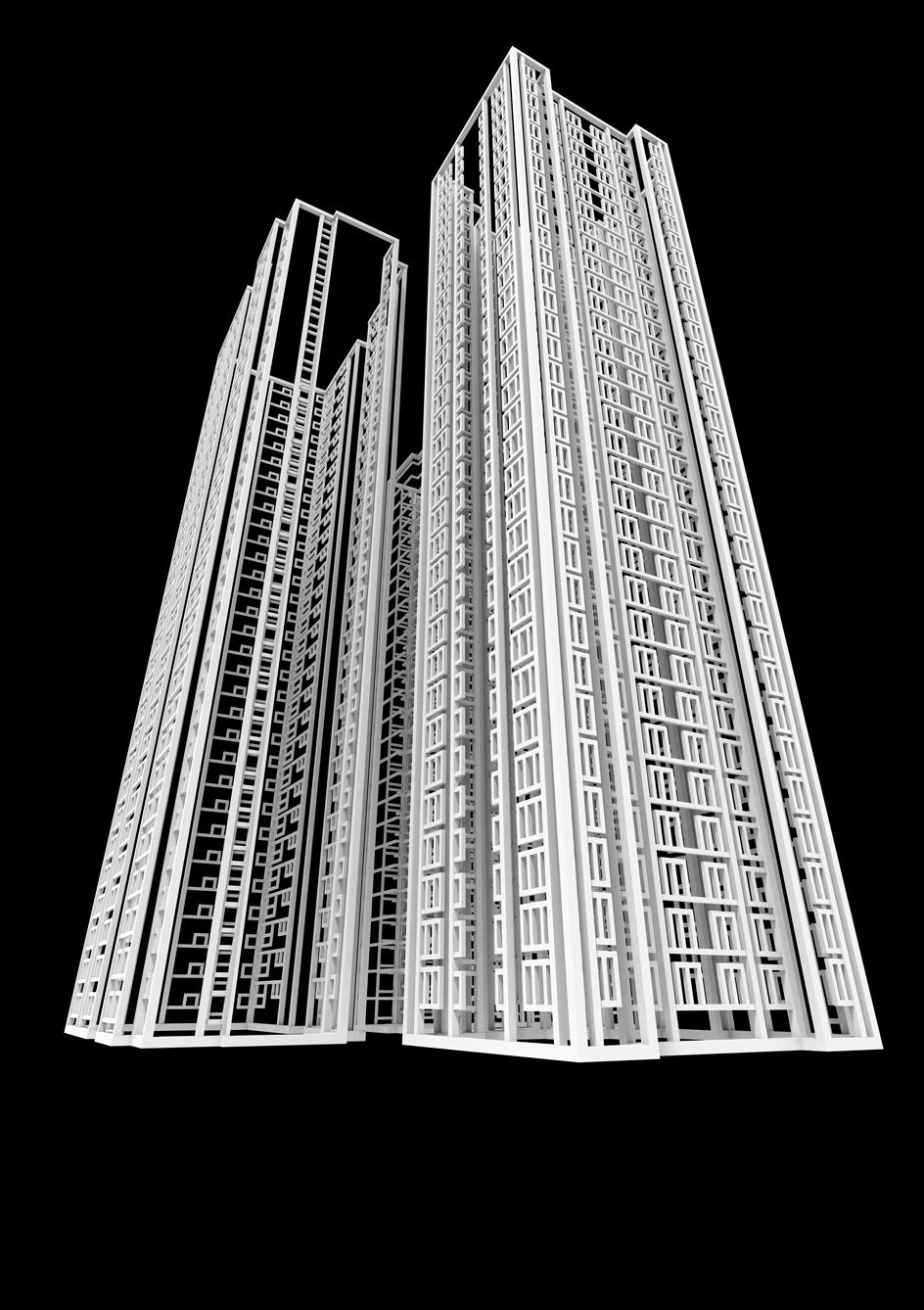
Julian Opie, 'OP.VR' detail
W*: What role does social media play in your work?
JO: I don’t know anything about social media except what I see over my kids’ shoulders. But like everyone, I use the internet to find things and I came across a homemade high-energy dance called ‘shuffle dancing’ that accompanies 2010s dance music. When I see something that I can use I feel a snap of recognition. I have drawn people walking for decades and was hungry for an alternative human movement that was easily recognisable and sufficiently short and repetitive to animate in an endless loop. With my second daughter, Imogen, an actor and dancer, we isolated five simple but fluid movements from the videos that could be danced and repeated. She taught three other dancers the moves and I filmed them at 50 frames per second to 100bpm dance music, then drew them in colours taken from nylon ski wear I photographed on a ski trip with my son, Paul. The project turned into five dances in a series of multiple films and paintings with tracks composed by a young musician, Archie Wingate.
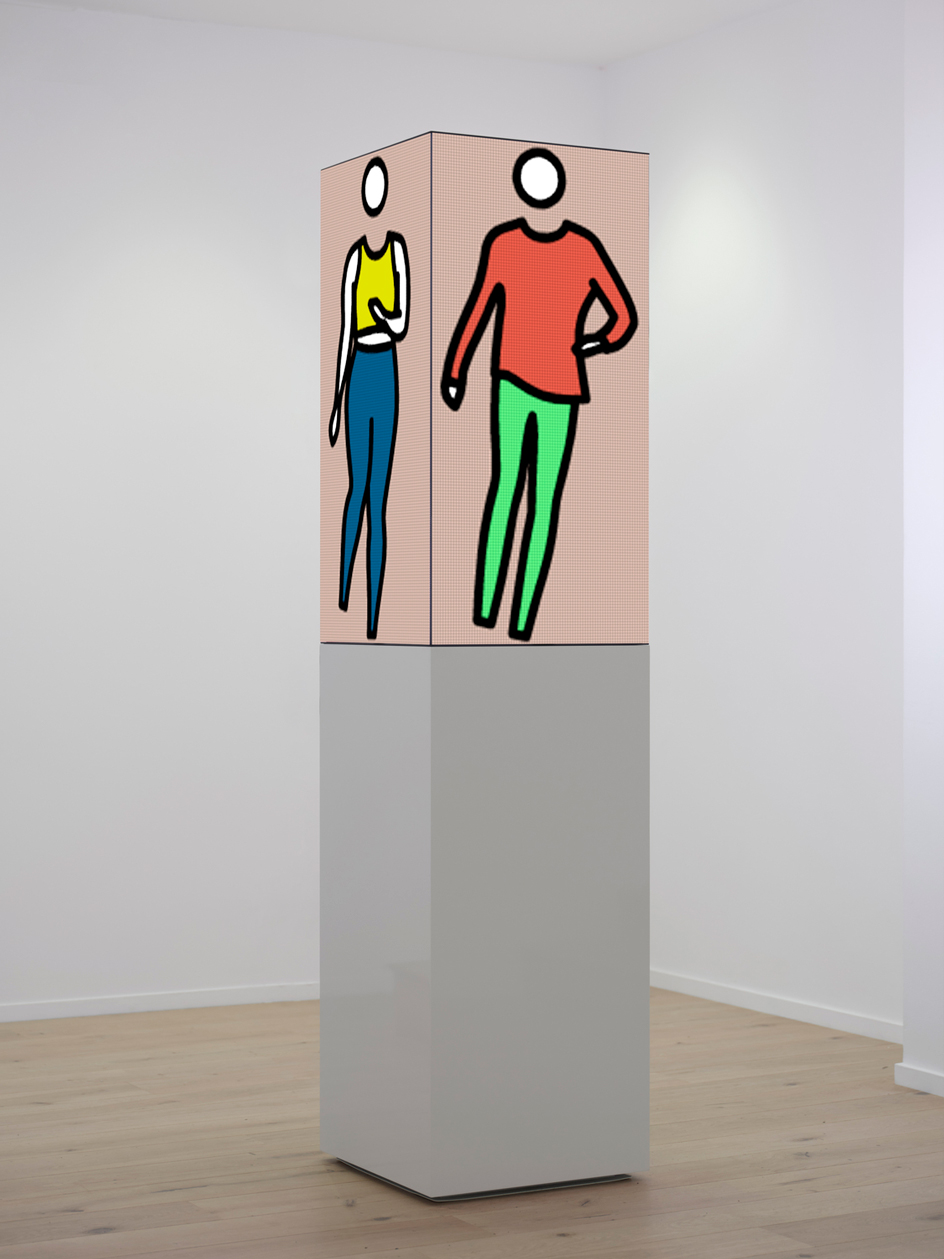
Installation view: 'Julian Opie, OP.VR@LISSON/London'
W*: What do you love most about exhibiting art in public spaces?
JO: I love the idea of being out in the real world. Museums and galleries are fantastic places to show and see art but it’s a captive audience and a step away from the rest of the world. A public commission is a chance to be out amongst everything else, to reflect and merge into the real world where the works originated. I have a moving sculpture on Carnaby Street that depicts a walking shopper in the electronic language of traffic signals and shop signs. I wanted to bend the surrounding languages into my own drawing. In Melbourne I have 30 animated Australian birds pecking and walking along a long traffic island as if the fabric of the road merged with the wildlife. People who pass don’t know what it is and only interact if they are interested. The work is not bracketed by an institution, it’s just there amongst the clutter of the street. I’m aware that public art can be pretty annoying, like someone else’s loud radio on the beach, but I try to ingratiate and amuse like a street juggler and disguise what I do in the pre-existing language of the environment.
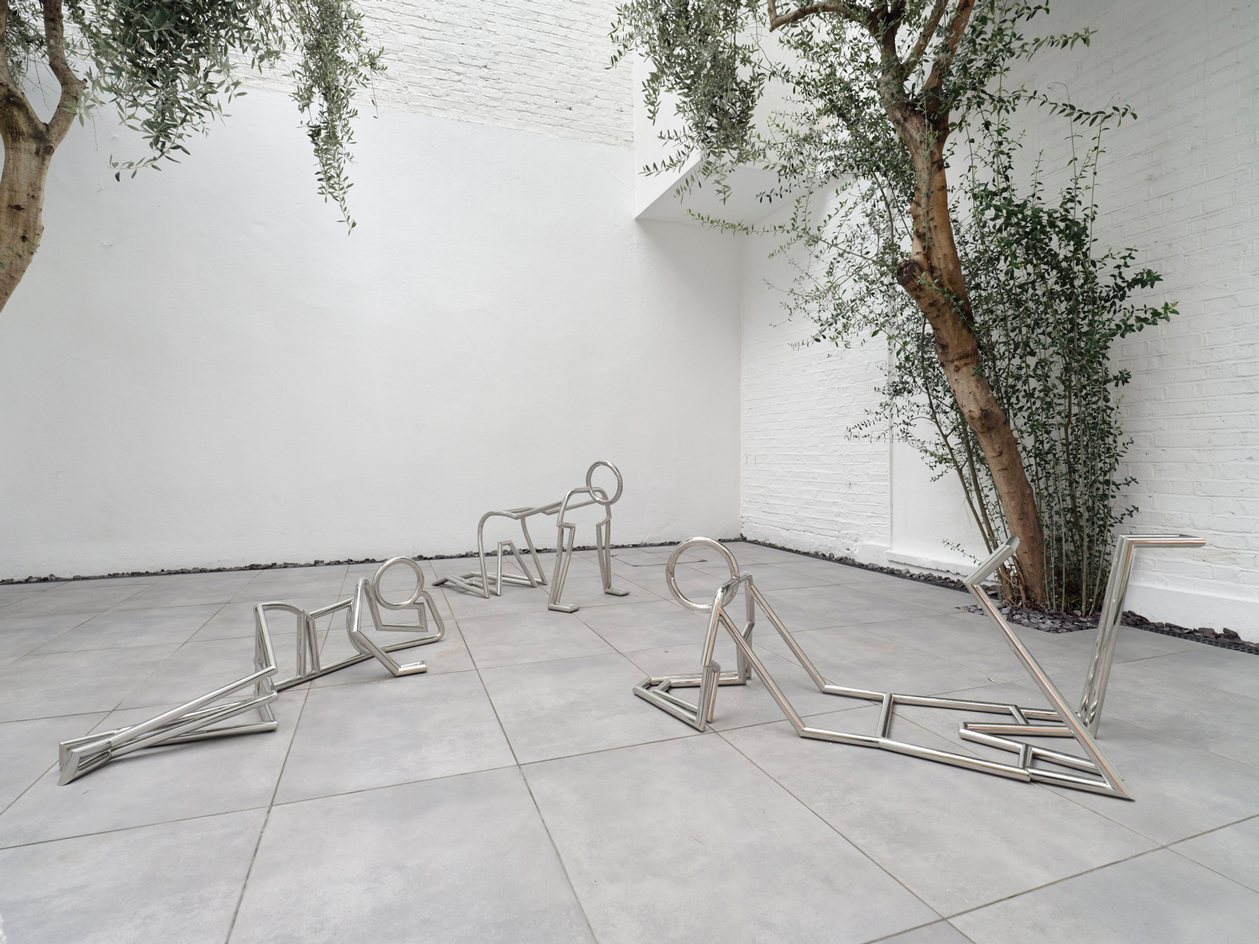
Installation view: Julian Opie, 'OP.VR@LISSON/London'
W*: What are you working on at the moment, and how’s it going?
JO: It’s going well thanks. At some point, I might like to slow down but not until I have to. I’m pretty busy this spring with the London show, two exhibitions in China, one in South Korea and another coming up in Rome. Exhibiting is very much a part of making the work for me – that’s where I really get to see them and feel they exist. I photographed and drew 20 people in Busan for the South Korean show and I’m working on a live work that will use real people on walking machines to make living paintings. It sounds ridiculous, but it might work. I’d also like to draw some toddlers walking to make some very small sculptures based on historical Indonesian sculptures. After that, it’s a bit of a blank. VR 2?
W*: What piece of advice would you give to the next generation?
JO: I’m 64. The next generation is already nearing retirement. I’m not big on advice. I just get on with what I enjoy and throw my energy into whatever is on offer.
Julian Opie: 'OP.VR@LISSON/London', until 15 April 2023. lissongallery.com
Harriet Lloyd-Smith was the Arts Editor of Wallpaper*, responsible for the art pages across digital and print, including profiles, exhibition reviews, and contemporary art collaborations. She started at Wallpaper* in 2017 and has written for leading contemporary art publications, auction houses and arts charities, and lectured on review writing and art journalism. When she’s not writing about art, she’s making her own.
-
 Put these emerging artists on your radar
Put these emerging artists on your radarThis crop of six new talents is poised to shake up the art world. Get to know them now
By Tianna Williams
-
 Dining at Pyrá feels like a Mediterranean kiss on both cheeks
Dining at Pyrá feels like a Mediterranean kiss on both cheeksDesigned by House of Dré, this Lonsdale Road addition dishes up an enticing fusion of Greek and Spanish cooking
By Sofia de la Cruz
-
 Creased, crumpled: S/S 2025 menswear is about clothes that have ‘lived a life’
Creased, crumpled: S/S 2025 menswear is about clothes that have ‘lived a life’The S/S 2025 menswear collections see designers embrace the creased and the crumpled, conjuring a mood of laidback languor that ran through the season – captured here by photographer Steve Harnacke and stylist Nicola Neri for Wallpaper*
By Jack Moss
-
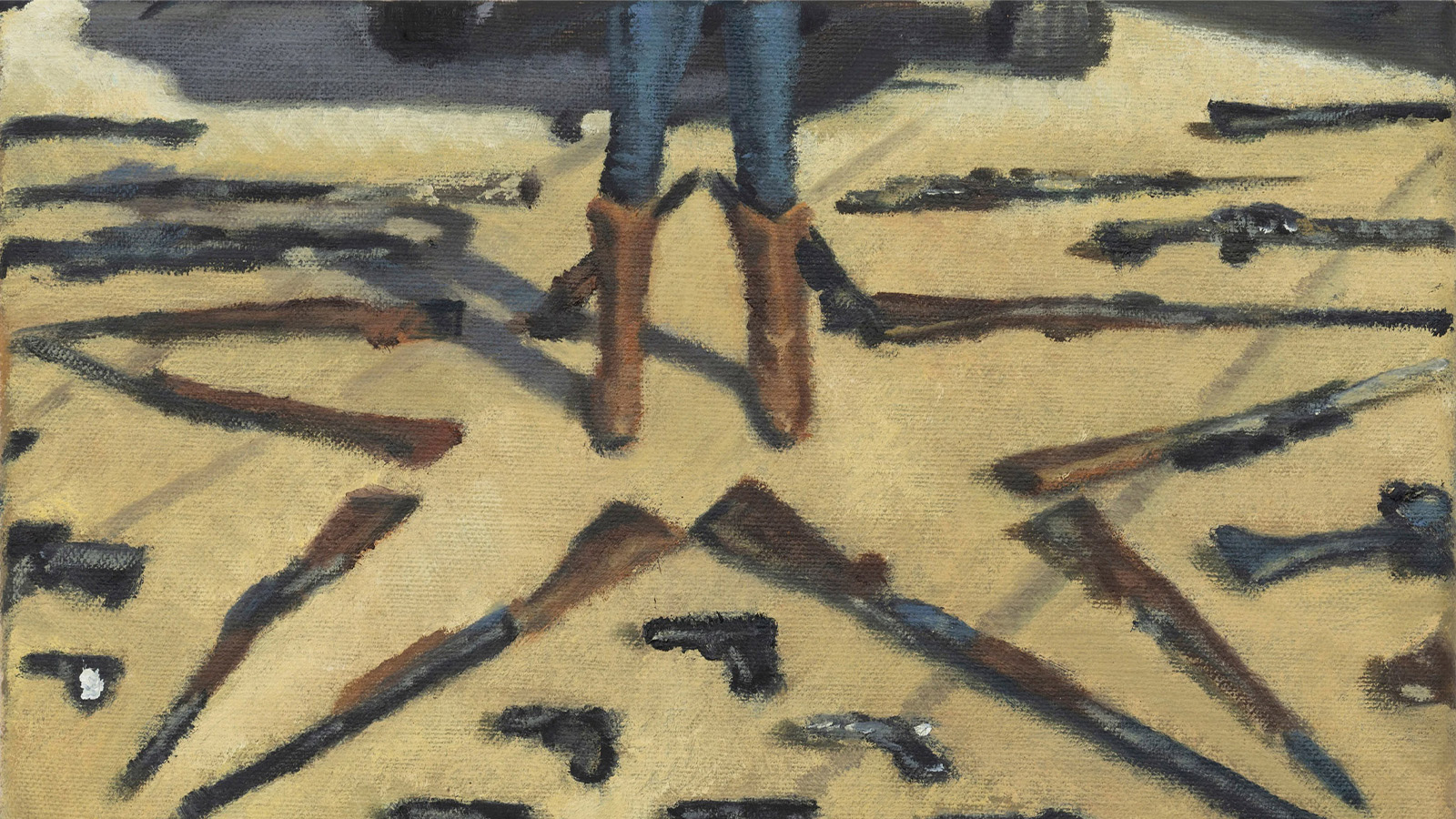 Los Angeles art exhibitions: the best shows to see in April 2025
Los Angeles art exhibitions: the best shows to see in April 2025Read our pick of the best Los Angeles art exhibitions to see this month, from Issy Wood's confession and concealment at Michael Werner Gallery to a Diane Arbus retrospective at David Zwirner
By Carole Dixon
-
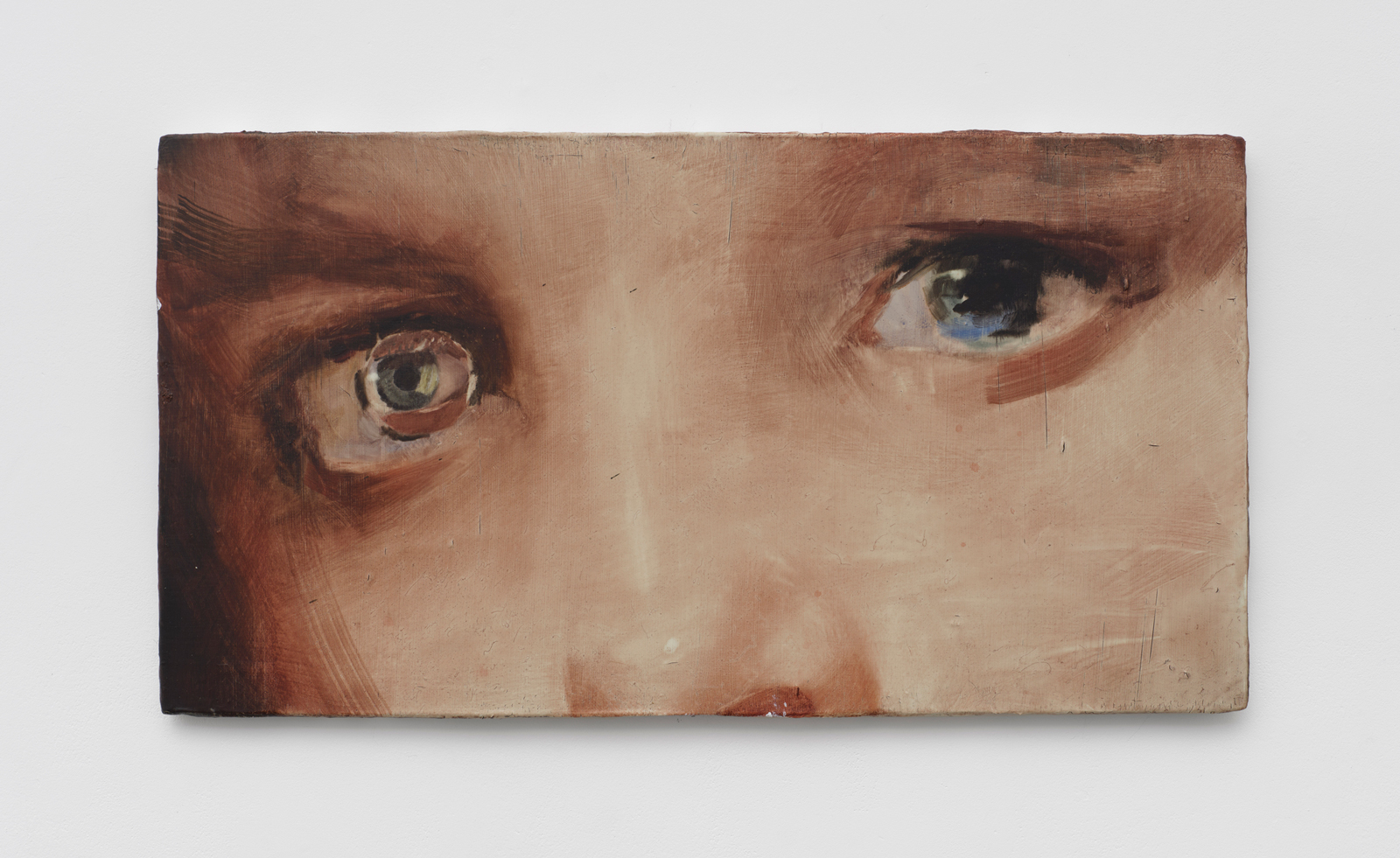 ‘Accordion Fields’ at Lisson Gallery unites painters inspired by London
‘Accordion Fields’ at Lisson Gallery unites painters inspired by London‘Accordian Fields’ at Lisson Gallery is a group show looking at painting linked to London
By Amah-Rose Abrams
-
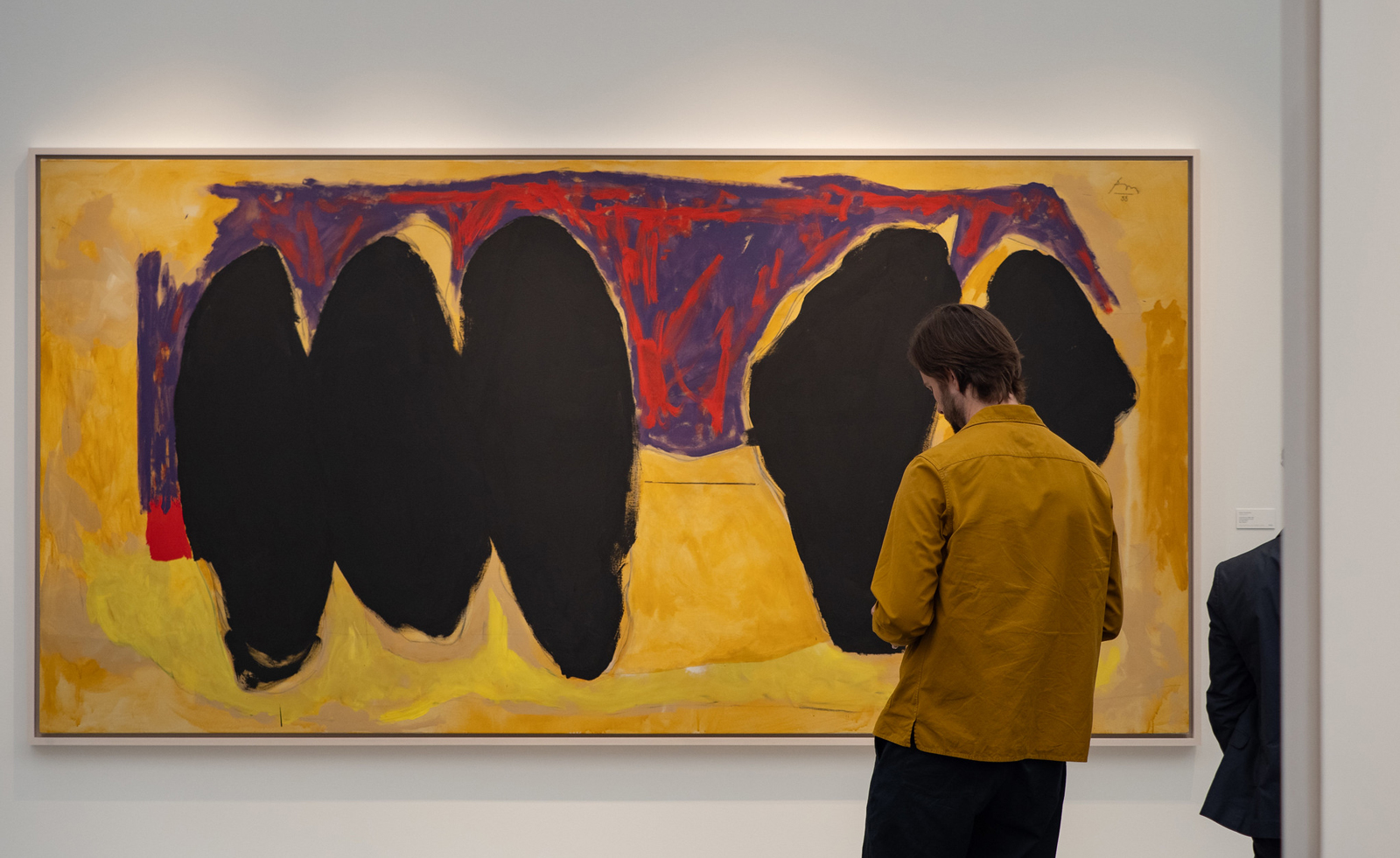 Frieze London 2023: what to see and do
Frieze London 2023: what to see and doEverything you want to see at Frieze London 2023 and around the city in our frequently updated guide
By Hannah Silver
-
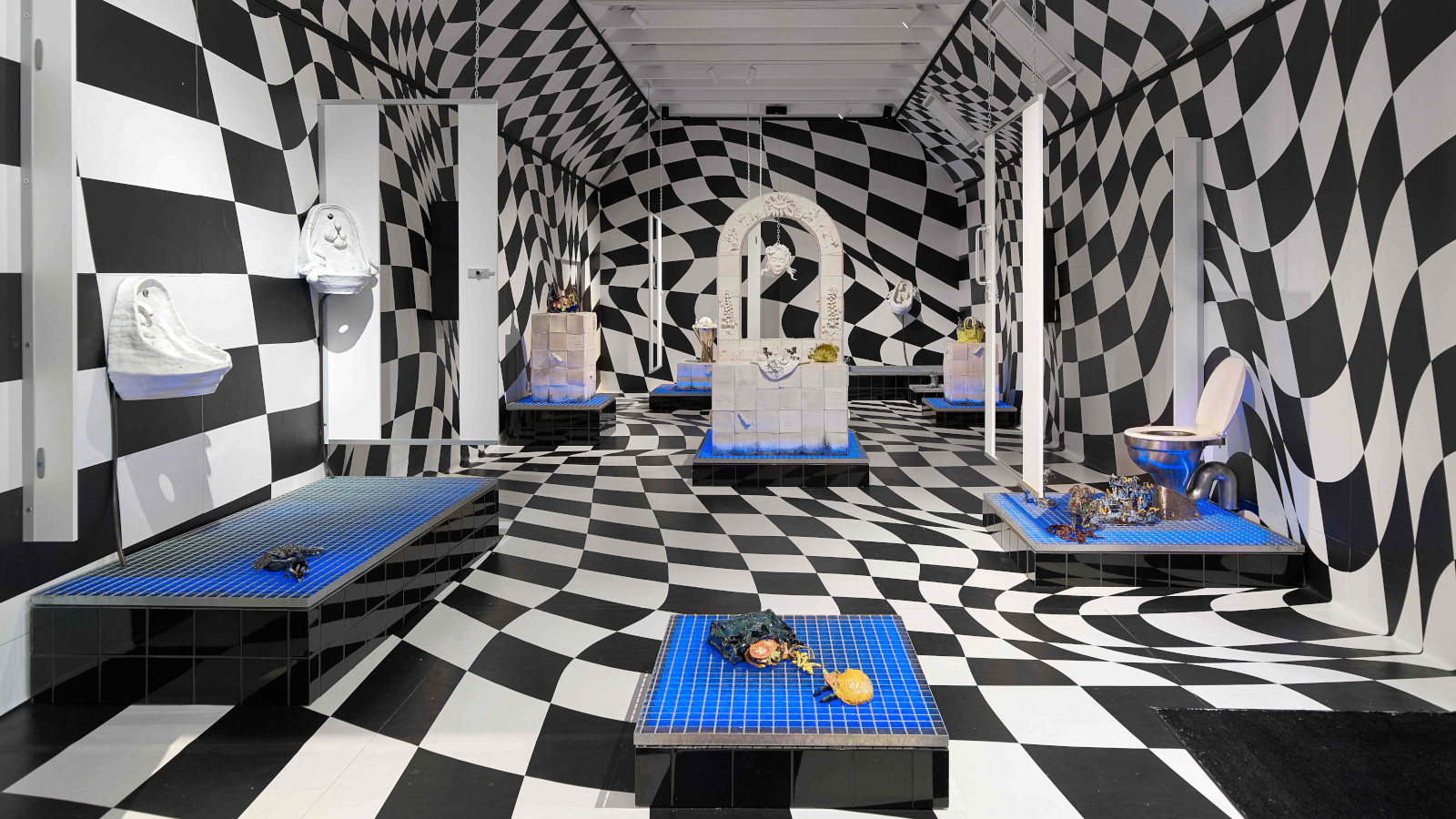 Edinburgh Art Festival 2023: from bog dancing to binge drinking
Edinburgh Art Festival 2023: from bog dancing to binge drinkingWhat to see at Edinburgh Art Festival 2023, championing women and queer artists, whether exploring Scottish bogland on film or casting hedonism in ceramic
By Amah-Rose Abrams
-
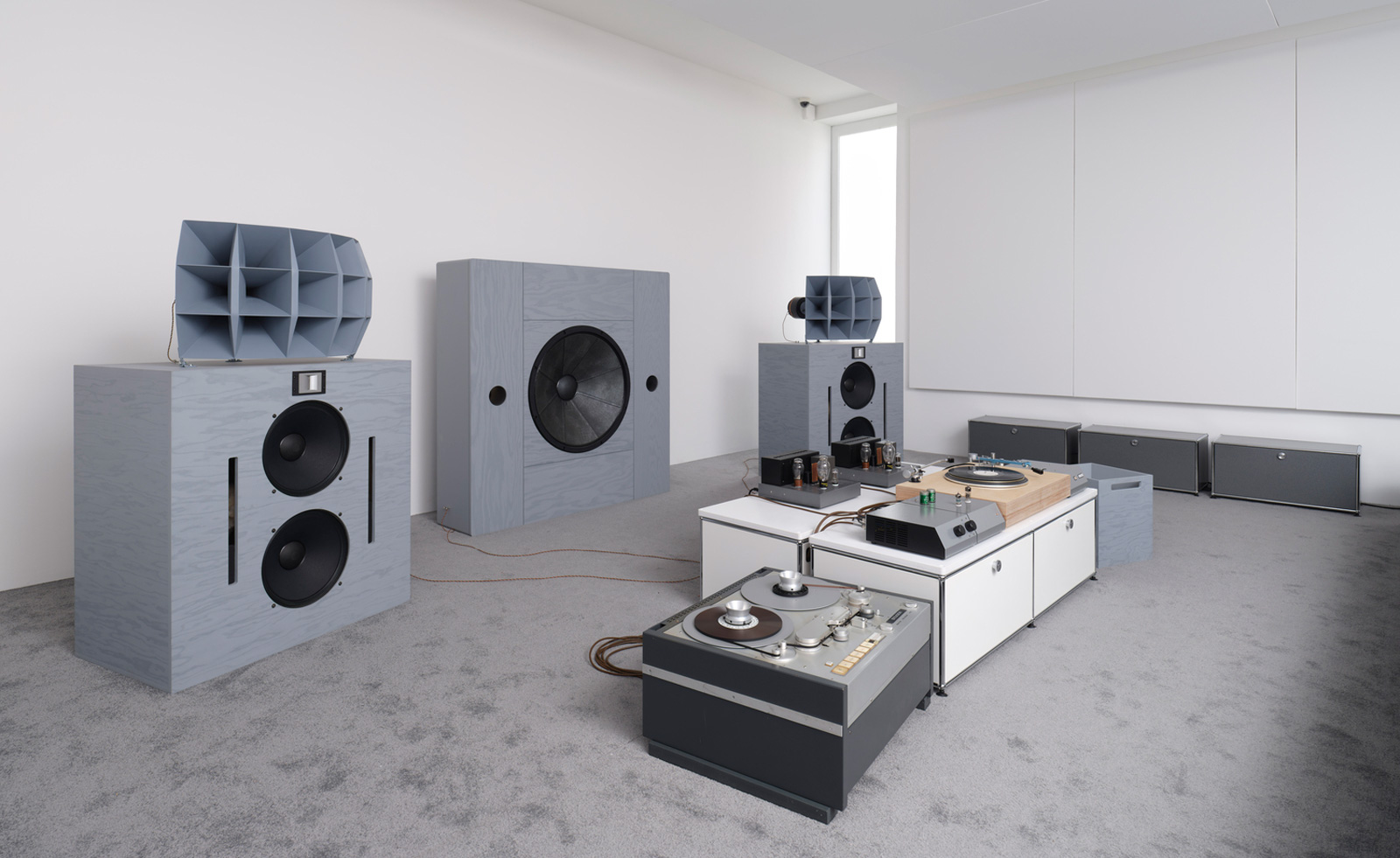 Last chance to see: Devon Turnbull’s ‘HiFi Listening Room Dream No. 1’ at Lisson Gallery, London
Last chance to see: Devon Turnbull’s ‘HiFi Listening Room Dream No. 1’ at Lisson Gallery, LondonDevon Turnbull/OJAS’ handmade sound system matches minimalist aesthetics with a profound audiophonic experience – he tells us more
By Jorinde Croese
-
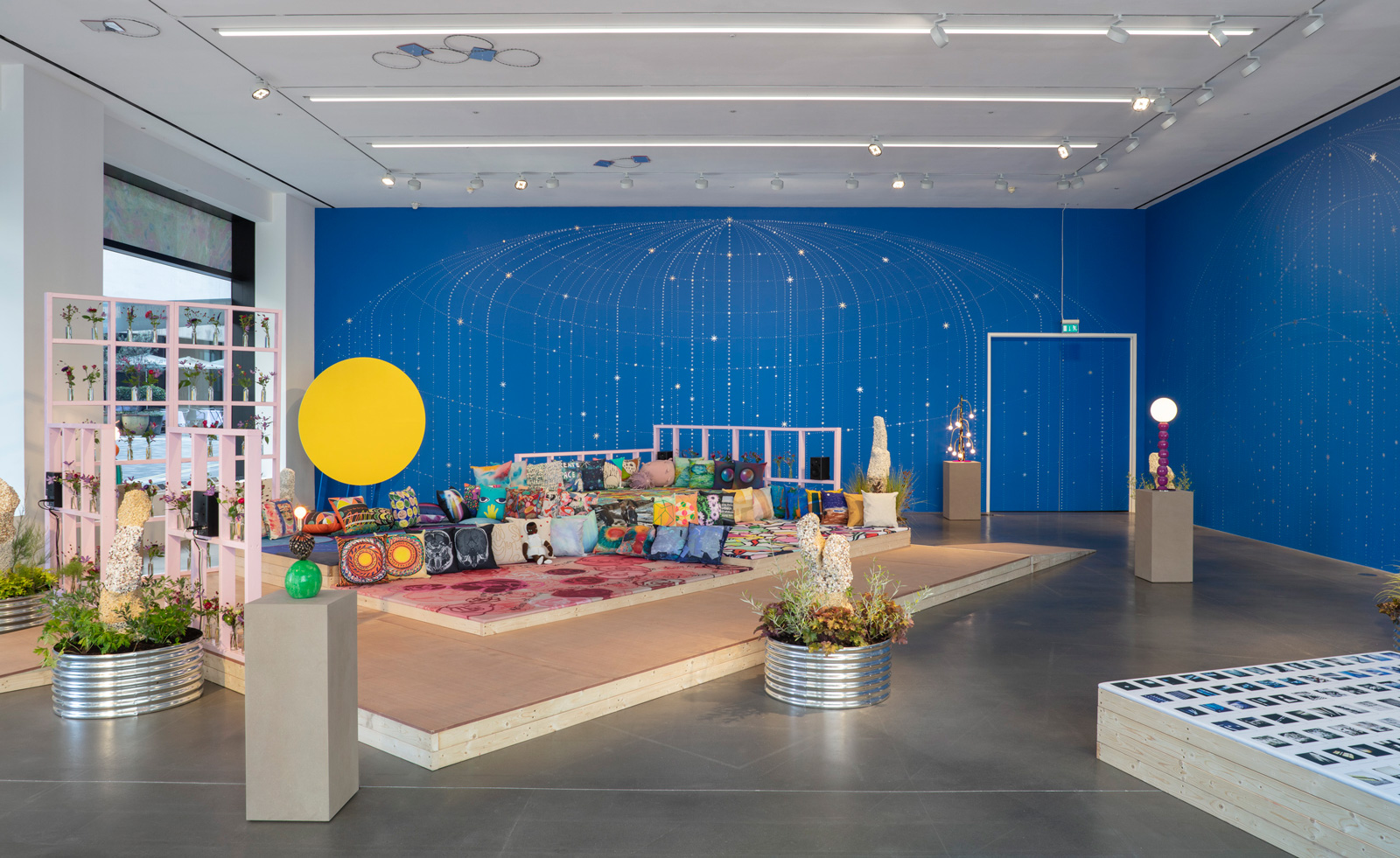 Hospital Rooms and Hauser & Wirth unite for a sensorial London exhibition and auction
Hospital Rooms and Hauser & Wirth unite for a sensorial London exhibition and auctionHospital Rooms and Hauser & Wirth are working together to raise money for arts and mental health charities
By Hannah Silver
-
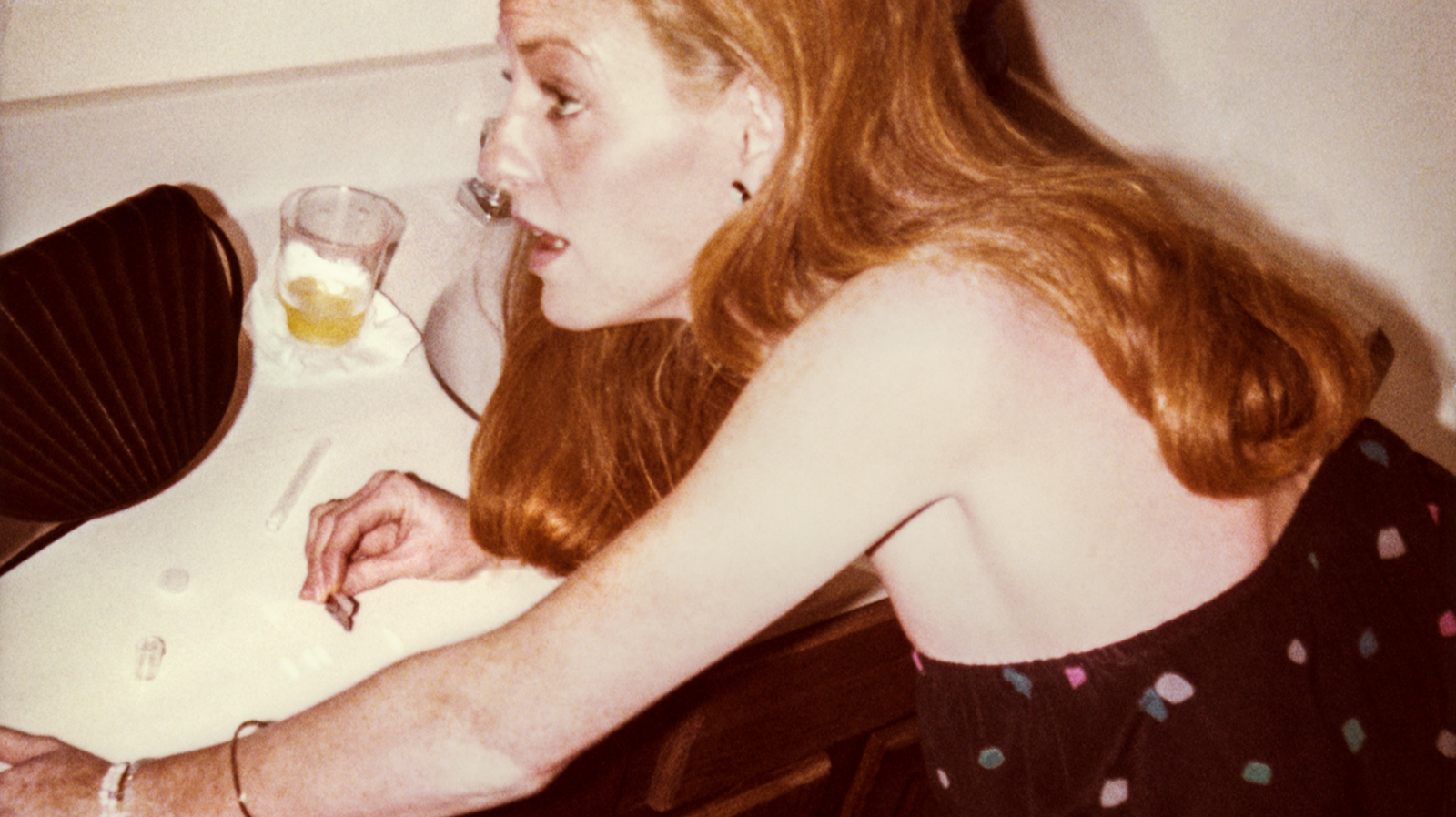 ‘These Americans’: Will Vogt documents the USA’s rich at play
‘These Americans’: Will Vogt documents the USA’s rich at playWill Vogt’s photo book ‘These Americans’ is a deep dive into a world of privilege and excess, spanning 1969 to 1996
By Sophie Gladstone
-
 Brian Eno extends his ambient realms with these environment-altering sculptures
Brian Eno extends his ambient realms with these environment-altering sculpturesBrian Eno exhibits his new light box sculptures in London, alongside a unique speaker and iconic works by the late American light artist Dan Flavin
By Jonathan Bell